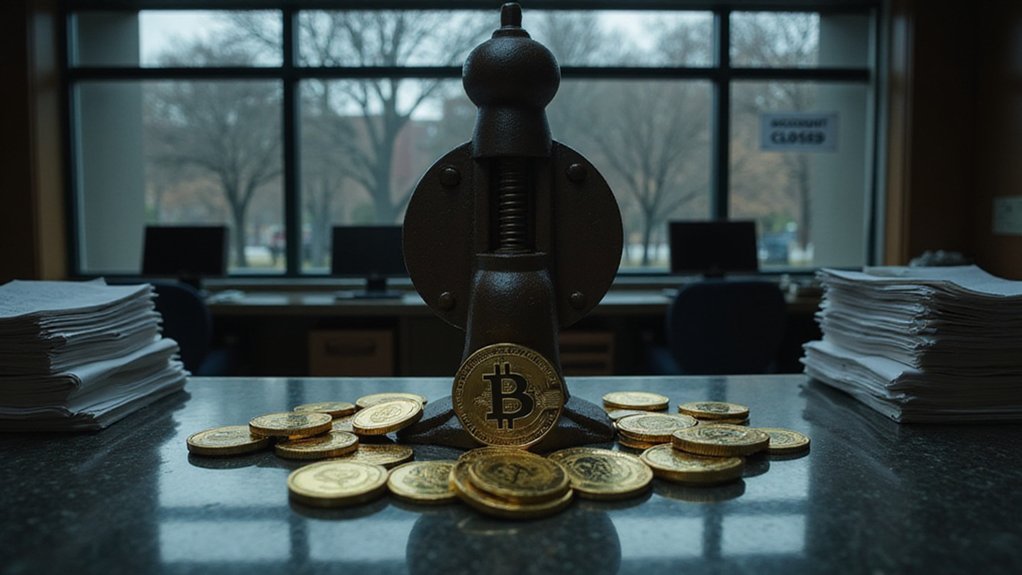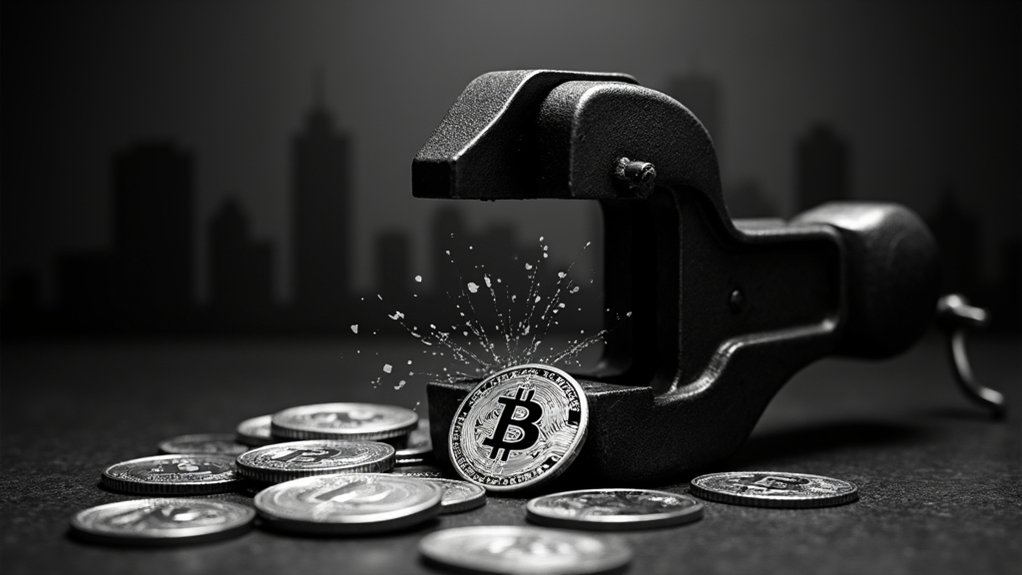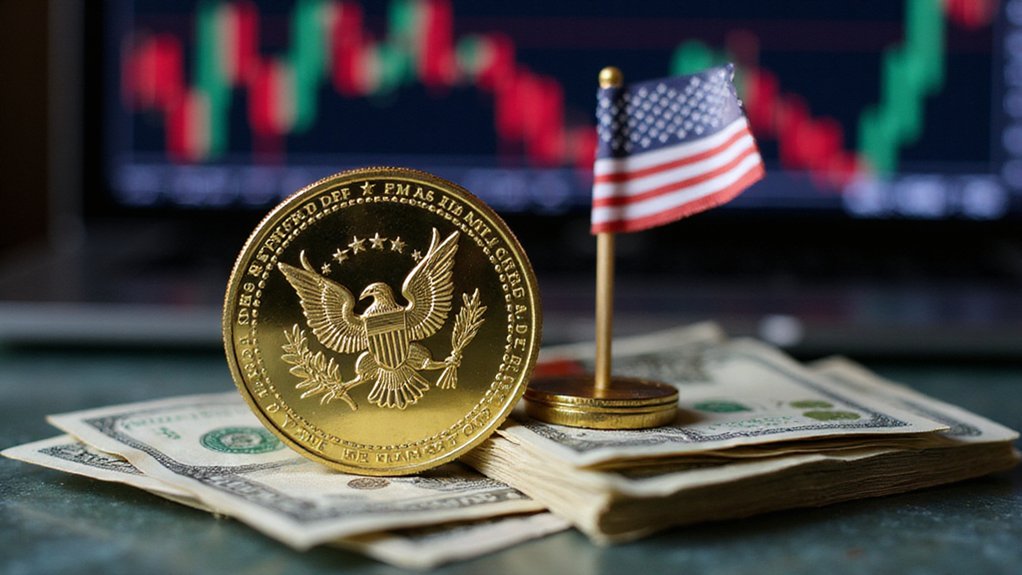Operation Chokepoint 2.0 represents an unofficial regulatory campaign targeting cryptocurrency firms through coordinated federal agency actions. This sequel to the 2013 initiative manifests as systematic de-banking, where crypto companies face severed financial relationships, opaque compliance guidance, and exhaustive regulatory burdens. Despite bipartisan congressional concerns about overreach, cryptocurrency businesses continue maneuvering this hostile landscape while seeking legislative remedies. The phenomenon showcases the precarious balance between legitimate financial oversight and America’s purported commitment to technological innovation—a tension unlikely to resolve without substantial policy shifts.

Cryptocurrency firms find themselves caught in an increasingly complex regulatory vise as what industry insiders have dubbed “Operation Chokepoint 2.0” tightens its grip on digital asset businesses across the United States.
Unlike its predecessor—a 2013 Obama-era initiative targeting high-risk industries like payday lending and firearms—this unofficial sequel manifests as a more coordinated effort across federal agencies, leaving crypto entrepreneurs scrambling for financial lifelines.
The de-banking phenomenon afflicting crypto companies bears the hallmarks of deliberate regulatory orchestration.
The systematic severing of banking relationships resembles a coordinated regulatory offensive, leaving crypto firms financially stranded by design.
Multiple agencies—FDIC, DOJ, OCC, and FinCEN—appear synchronized in their approach, with evidence suggesting regional offices executing identical strategies.
Banking access, that most fundamental of commercial prerequisites, has become a luxury good for digital asset firms (one wonders if they’ll soon need to barter with their own tokens for basic financial services).
What’s particularly vexing is the opacity surrounding these actions.
Regulatory guidance remains frustratingly nebulous—a feature, not a bug, critics might suggest—leaving firms to navigate treacherous compliance waters without adequate navigational charts.
The resulting uncertainty introduces market volatility that, ironically, reinforces regulators’ risk narratives.
Congressional attention has materialized through bipartisan expressions of concern.
Hearings have illuminated the tension between legitimate financial crime prevention and potential regulatory overreach.
Meanwhile, the industry’s lobbying machinery works overtime seeking legislative and legal remedies, even as investment capital grows increasingly skittish.
The stakes transcend mere market dynamics.
This new wave of regulatory pressure follows directly in the footsteps of the original Operation Choke Point, which relied heavily on subjective reputational risk to justify supervisory actions against legally operating businesses.
At issue is the fundamental question of innovation policy: can American regulatory frameworks accommodate transformative technologies without suffocating them?
The regulatory balancing act—between financial stability, consumer protection, and technological advancement—defies easy resolution.
As this unofficial “Operation Chokepoint 2.0” unfolds, its economic impact reverberates beyond cryptocurrency valuations, potentially constraining job creation and technological advancement in blockchain ecosystems.
The industry’s ultimate fate may depend less on technological breakthrough than on achieving that most elusive of modern commodities: regulatory clarity.
Testimony from Coinbase’s Paul Grewal highlighted how FDIC pause letters have effectively become permanent restrictions, creating an exhaustive regulatory burden without clear resolution pathways.
The Trump administration’s appointment of David Sacks as Crypto Czar and establishment of a Strategic Bitcoin Reserve may signal a significant policy shift toward embracing rather than stifling cryptocurrency innovation.
Frequently Asked Questions
How Can Crypto Businesses Protect Themselves From Regulatory Overreach?
Crypto businesses facing regulatory headwinds must deploy multi-pronged defensive strategies.
Rigorous compliance protocols (particularly AML/KYC), strategic banking relationships across multiple institutions, and domiciling in crypto-friendly jurisdictions form the foundation.
Simultaneously, proactive litigation challenging regulatory overreach and industry consortium participation can create structural protection.
The truly savvy operators maintain substantial legal reserves—a prudent insurance policy when operating in regulatory gray zones where interpretations shift with alarming regularity.
What Legal Recourse Do Affected Crypto Companies Have?
Affected crypto companies have several legal avenues to pursue: constitutional challenges based on Fifth Amendment due process violations; litigation citing the non-delegation and anticommandeering doctrines; administrative procedure lawsuits challenging arbitrary decision-making; and legislative advocacy for regulatory reform.
Previous successful challenges to Operation Chokepoint provide helpful precedent.
Companies might also consider joining industry associations for class action lawsuits—strength in numbers being particularly valuable when confronting what appears to be coordinated regulatory pressure (however unofficially orchestrated).
Which Cryptocurrencies Are Most Vulnerable to Operation Chokepoint 2.0?
Stablecoins (USDT, USDC) stand most vulnerable due to their explicit dependence on banking partners for fiat reserves, followed by institutional custody tokens requiring regulated settlement systems.
Closely behind are compliance-heavy tokens needing licensed trust charters and exchange tokens collateralized through banking relationships.
Even algorithmic stablecoins without 1:1 reserves remain exposed during crises when emergency banking facilities become critical.
Smaller-cap altcoins with limited banking relationships round out this precarious cohort facing potential financial isolation.
How Does Operation Chokepoint 2.0 Differ Internationally?
Operation Chokepoint 2.0 manifests distinctly across jurisdictions.
While the U.S. leverages banking restrictions and regulatory pressure, the EU formalizes crypto through MiCA licensing frameworks.
The UK adopts innovation-friendly sandboxes, avoiding America’s de-banking zeal.
Asia-Pacific presents a regulatory mosaic—Singapore’s structured licensing contrasting with India’s cautious scrutiny.
Meanwhile, Middle Eastern hubs like Dubai prioritize formal oversight over banking severance, creating a global patchwork where crypto firms increasingly engage in jurisdictional arbitrage.
Can Decentralized Finance Solutions Circumvent These Banking Restrictions?
DeFi solutions can indeed circumvent banking restrictions through their inherently decentralized architecture.
By eliminating intermediaries and leveraging peer-to-peer networks, these platforms enable transactions outside traditional banking channels.
Smart contracts automate compliance while preserving anonymity, and cross-border functionality renders geographical restrictions largely moot.
However, this regulatory arbitrage isn’t without risk—DeFi’s wild west remains vulnerable to eventual regulatory encirclement, with authorities increasingly targeting on/off ramps where fiat currency interfaces with the crypto ecosystem.









